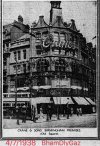Jayell
master brummie
I've just found a connection to the Old Square and wonder if anyone can shed any light on these people who married into my family - James Creshull (b. about 1764) who was a Cabinet Maker and Upholster, and whose address was The Square in the 1818 Wighton's Directory. Also his son Thomas Creshull was was a Professor of Dancing at 10 Old Square in various directories from at least 1818- he was also a tobacconist at 105 New Street and had an address 103 Broad Street too. His address on his death was Upper Priory. This is still a work in progress so I have no more information!










